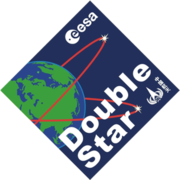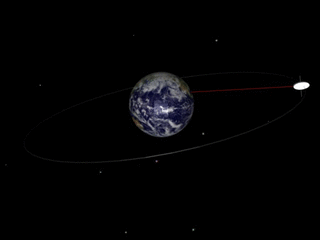
A geosynchronous orbit is an Earth-centered orbit with an orbital period that matches Earth's rotation on its axis, 23 hours, 56 minutes, and 4 seconds. The synchronization of rotation and orbital period means that, for an observer on Earth's surface, an object in geosynchronous orbit returns to exactly the same position in the sky after a period of one sidereal day. Over the course of a day, the object's position in the sky may remain still or trace out a path, typically in a figure-8 form, whose precise characteristics depend on the orbit's inclination and eccentricity. A circular geosynchronous orbit has a constant altitude of 35,786 km (22,236 mi).
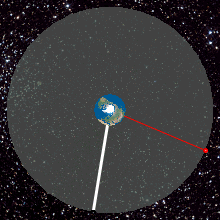
A geostationary orbit, also referred to as a geosynchronous equatorial orbit (GEO), is a circular geosynchronous orbit 35,786 km (22,236 mi) in altitude above Earth's equator, 42,164 km (26,199 mi) in radius from Earth's center, and following the direction of Earth's rotation.
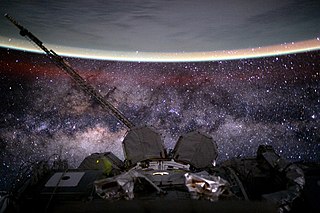
A low Earth orbit (LEO) is an orbit around Earth with a period of 128 minutes or less and an eccentricity less than 0.25. Most of the artificial objects in outer space are in LEO, peaking in number at an altitude around 800 km (500 mi), while the farthest in LEO, before medium Earth orbit (MEO), have an altitude of 2,000 kilometers, about one-third of the radius of Earth and near the beginning of the inner Van Allen radiation belt.

Orbital inclination measures the tilt of an object's orbit around a celestial body. It is expressed as the angle between a reference plane and the orbital plane or axis of direction of the orbiting object.

Ulysses was a robotic space probe whose primary mission was to orbit the Sun and study it at all latitudes. It was launched in 1990 and made three "fast latitude scans" of the Sun in 1994/1995, 2000/2001, and 2007/2008. In addition, the probe studied several comets. Ulysses was a joint venture of the European Space Agency (ESA) and the United States' National Aeronautics and Space Administration (NASA), under leadership of ESA with participation from Canada's National Research Council. The last day for mission operations on Ulysses was 30 June 2009.

In space mission design, a geostationary transfer orbit (GTO) or geosynchronous transfer orbit is a highly elliptical type of geocentric orbit, usually with a perigee as low as low Earth orbit (LEO) and an apogee as high as geostationary orbit (GEO). Satellites that are destined for geosynchronous orbit (GSO) or GEO are often put into a GTO as an intermediate step for reaching their final orbit. Manufacturers of launch vehicles often advertise the amount of payload the vehicle can put into GTO.

A polar orbit is one in which a satellite passes above or nearly above both poles of the body being orbited on each revolution. It has an inclination of about 60–90 degrees to the body's equator.
A geocentric orbit, Earth-centered orbit, or Earth orbit involves any object orbiting Earth, such as the Moon or artificial satellites. In 1997, NASA estimated there were approximately 2,465 artificial satellite payloads orbiting Earth and 6,216 pieces of space debris as tracked by the Goddard Space Flight Center. More than 16,291 objects previously launched have undergone orbital decay and entered Earth's atmosphere.

A Sun-synchronous orbit (SSO), also called a heliosynchronous orbit, is a nearly polar orbit around a planet, in which the satellite passes over any given point of the planet's surface at the same local mean solar time. More technically, it is an orbit arranged so that it precesses through one complete revolution each year, so it always maintains the same relationship with the Sun.
In astrodynamics, orbital station-keeping is keeping a spacecraft at a fixed distance from another spacecraft or celestial body. It requires a series of orbital maneuvers made with thruster burns to keep the active craft in the same orbit as its target. For many low Earth orbit satellites, the effects of non-Keplerian forces, i.e. the deviations of the gravitational force of the Earth from that of a homogeneous sphere, gravitational forces from Sun/Moon, solar radiation pressure and air drag, must be counteracted. For spacecraft in a halo orbit around a Lagrange point, station-keeping is even more fundamental, as such an orbit is unstable; without an active control with thruster burns, the smallest deviation in position or velocity would result in the spacecraft leaving orbit completely.

The Solar Orbiter (SolO) is a Sun-observing probe developed by the European Space Agency (ESA) with a National Aeronautics and Space Administration (NASA) contribution. Solar Orbiter, designed to obtain detailed measurements of the inner heliosphere and the nascent solar wind, will also perform close observations of the polar regions of the Sun which is difficult to do from Earth. These observations are important in investigating how the Sun creates and controls its heliosphere.

Cluster II was a space mission of the European Space Agency, with NASA participation, to study the Earth's magnetosphere over the course of nearly two solar cycles. The mission was composed of four identical spacecraft flying in a tetrahedral formation. As a replacement for the original Cluster spacecraft which were lost in a launch failure in 1996, the four Cluster II spacecraft were successfully launched in pairs in July and August 2000 onboard two Soyuz-Fregat rockets from Baikonur, Kazakhstan. In February 2011, Cluster II celebrated 10 years of successful scientific operations in space. In February 2021, Cluster II celebrated 20 years of successful scientific operations in space. As of March 2023, its mission was extended until September 2024. The China National Space Administration/ESA Double Star mission operated alongside Cluster II from 2004 to 2007.

Ørsted is an Earth science satellite launched in 1999 to study the Earth's geomagnetic field. It is Denmark's first satellite, named after Hans Christian Ørsted (1777–1851), a Danish physicist and professor at the University of Copenhagen, who discovered electromagnetism in 1820.

A Tundra orbit is a highly elliptical geosynchronous orbit with a high inclination, an orbital period of one sidereal day, and a typical eccentricity between 0.2 and 0.3. A satellite placed in this orbit spends most of its time over a chosen area of the Earth, a phenomenon known as apogee dwell, which makes them particularly well suited for communications satellites serving high-latitude regions.

The Global Geospace Science (GGS) Polar satellite was a NASA science spacecraft designed to study the polar magnetosphere and aurorae. It was launched into orbit in February 1996, and continued operations until the program was terminated in April 2008. The spacecraft remains in orbit, though it is now inactive. Polar is the sister ship to GGS Wind.
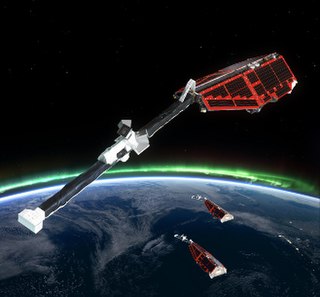
Swarm is a European Space Agency (ESA) mission to study the Earth's magnetic field. High-precision and high-resolution measurements of the strength, direction and variations of the Earth's magnetic field, complemented by precise navigation, accelerometer and electric field measurements, will provide data for modelling the geomagnetic field and its interaction with other physical aspects of the Earth system. The results offer a view of the inside of the Earth from space, enabling the composition and processes of the interior to be studied in detail and increase our knowledge of atmospheric processes and ocean circulation patterns that affect climate and weather.

CryoSat-1, also known as just CryoSat, was a European Space Agency satellite which was lost in a launch failure in 2005. The satellite was launched as part of the European Space Agency's CryoSat mission, which aims to monitor ice in the high latitudes. The second mission satellite, CryoSat-2, was successfully launched in April 2010.
Global Geospace science program (GGS) is designed to improve greatly the understanding the flow of energy, mass and momentum in the solar-terrestrial environment with particular emphasis on geospace. GGS has primary scientific objective of its own:
